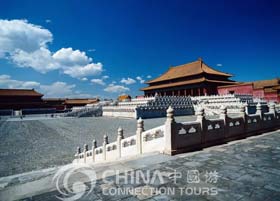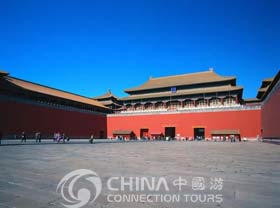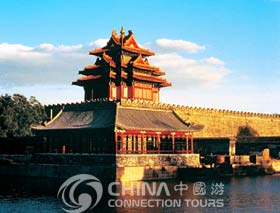
Also known as the Palace Museum, there are twenty-four emperors of the Ming and Qing dynasties lived in the Forbidden City, which got its name because it was off-limits to ordinary citizens and is the biggest and best-preserved cluster of ancient buildings in China. It was originally built in the 14th century, but because of fires and other catastrophes, it has been rebuilt several times.
 It lies 1 kilometer north of the Tian'anmen Square, with its south gate, the Gate of Devine Might (Shenwumen), facing the Jingshan Park. 960 meters long and 750 meters wide, the world largest palace complex covers a floor space of 720,000 square meters, having 9,999 buildings. The rectangular city is encircled in a 52-meter-wide, 6-meter-deep moat and a 10-meter-high, 3,400-meter-long city wall which has one gate on each side. There are four unique and delicate structured corner towers overlooking the city inside and outside on the four corners. Each of the four sides is pierced by a gate, the Meridian Gate (Wu men) on the south and the Gate of Spiritual Valor (Shenwu men) on the north being used as the entrance and exit by tourists today.
It lies 1 kilometer north of the Tian'anmen Square, with its south gate, the Gate of Devine Might (Shenwumen), facing the Jingshan Park. 960 meters long and 750 meters wide, the world largest palace complex covers a floor space of 720,000 square meters, having 9,999 buildings. The rectangular city is encircled in a 52-meter-wide, 6-meter-deep moat and a 10-meter-high, 3,400-meter-long city wall which has one gate on each side. There are four unique and delicate structured corner towers overlooking the city inside and outside on the four corners. Each of the four sides is pierced by a gate, the Meridian Gate (Wu men) on the south and the Gate of Spiritual Valor (Shenwu men) on the north being used as the entrance and exit by tourists today.
Generally, it was divided into two parts, the northern half, or the Outer Court where emperors executed their supreme power over the nation; and the southern half, or the Inner Court where they lived with their royal family. Until 1924 when the last emperor in China was driven out of the Inner Court, 14 emperors of the Ming dynasty and 10 emperors of the Qing dynasty had reigned here. About 500 years being the imperial palace, it houses numerous rare treasures and curiosities. It is now listed by the UN as World Cultural Heritage in 1987 and is the hottest tourist magnets.
 Construction of the palace complex started in 1407, the 5th year of the Yongle reign of the third emperor of the Ming dynasty, and was completed 14 years later in 1420. It was said that a million workers including 100,000 artisans were driven into the long-term hard labor. Stones needed were quarried from Fangshan, suburb of Beijing. It was said a well was dug along the road every 50 meters in order to pour water onto the road in winter to slide huge stones on ice into the city. Huge amount of timbers and other materials were all freighted from faraway provinces. Ancient Chinese people fully displayed their wisdom in building the Forbidden City. Take the grand red city wall for example, the ladder shaped wall has an 8.6 meters wide bottom and a 6.66 meters wide top. The shape of the city wall totally frustrate attempt to climb onto the wall. The bricks of the wall are said made from white lime and glutinous rice while the cement is made from glutinous rice and egg whites, and these incredible materials make the wall extraordinarily strong.
Construction of the palace complex started in 1407, the 5th year of the Yongle reign of the third emperor of the Ming dynasty, and was completed 14 years later in 1420. It was said that a million workers including 100,000 artisans were driven into the long-term hard labor. Stones needed were quarried from Fangshan, suburb of Beijing. It was said a well was dug along the road every 50 meters in order to pour water onto the road in winter to slide huge stones on ice into the city. Huge amount of timbers and other materials were all freighted from faraway provinces. Ancient Chinese people fully displayed their wisdom in building the Forbidden City. Take the grand red city wall for example, the ladder shaped wall has an 8.6 meters wide bottom and a 6.66 meters wide top. The shape of the city wall totally frustrate attempt to climb onto the wall. The bricks of the wall are said made from white lime and glutinous rice while the cement is made from glutinous rice and egg whites, and these incredible materials make the wall extraordinarily strong.
 Since yellow is the symbol of the royal family, it is the dominant color in the Forbidden City. Roofs are built with yellow glazed tiles; decorations in the palace are painted yellow; even the bricks on the ground are made yellow in special process. However, there is one exception. Wenyuange, the royal library, has a black roof. The reason is that it was believed black represented water then and could extinguish fire.
Since yellow is the symbol of the royal family, it is the dominant color in the Forbidden City. Roofs are built with yellow glazed tiles; decorations in the palace are painted yellow; even the bricks on the ground are made yellow in special process. However, there is one exception. Wenyuange, the royal library, has a black roof. The reason is that it was believed black represented water then and could extinguish fire.
Since 1997, the Palace Museum's administration has been significantly reorganized. Where previously there were three departments covering conservation, exhibition and research, these have now been split into the departments of Antiquities, Painting and Calligraphy, Palace Arts, and the Exhibition, Promotion and Education Department. Its surprisingly magnificent treasures will certainly satisfy "modern civilians".

